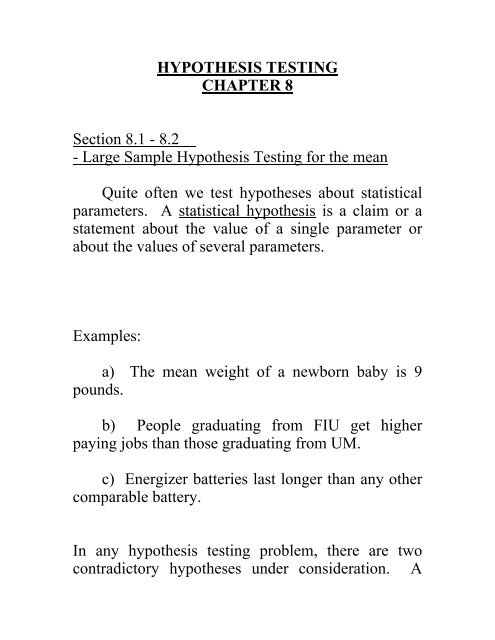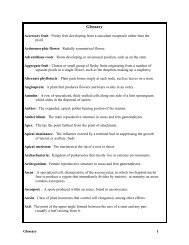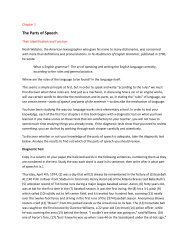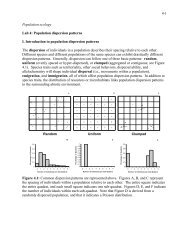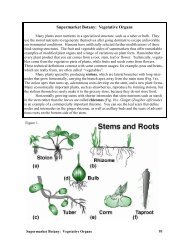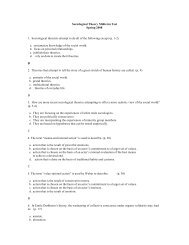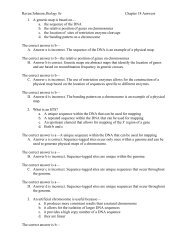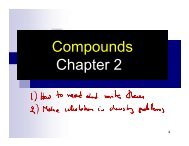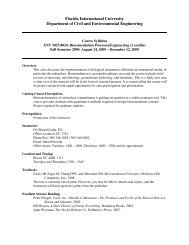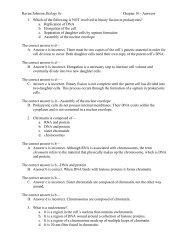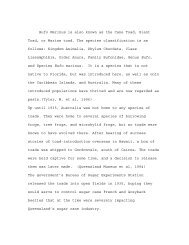HYPOTHESIS TESTING CHAPTER 8 Section 8.1 - 8.2 - Large ...
HYPOTHESIS TESTING CHAPTER 8 Section 8.1 - 8.2 - Large ...
HYPOTHESIS TESTING CHAPTER 8 Section 8.1 - 8.2 - Large ...
You also want an ePaper? Increase the reach of your titles
YUMPU automatically turns print PDFs into web optimized ePapers that Google loves.
<strong>HYPOTHESIS</strong> <strong>TESTING</strong><strong>CHAPTER</strong> 8<strong>Section</strong> <strong>8.1</strong> - <strong>8.2</strong>- <strong>Large</strong> Sample Hypothesis Testing for the meanQuite often we test hypotheses about statisticalparameters. A statistical hypothesis is a claim or astatement about the value of a single parameter orabout the values of several parameters.Examples:a) The mean weight of a newborn baby is 9pounds.b) People graduating from FIU get higherpaying jobs than those graduating from UM.c) Energizer batteries last longer than any othercomparable battery.In any hypothesis testing problem, there are twocontradictory hypotheses under consideration. A
statistical test of hypothesis is a method for decidingwhich of the two hypotheses is correct and is basedon the method of proof by contradiction. It iscomposed of the following five parts:1) The Null Hypothesis, denoted by H0.2) The Alternate Hypothesis, denoted by Ha.3) The Test Statistic, denoted by T.S.4) The Rejection Region or the CriticalRegion, denoted by R.R.5) The Conclusion.
Let us start with an example: Recall the MichelinTires example. Assume now that you buy the tiresfrom Firestone and that they claim that the meanlifetime of their tires is 41,000 miles. You are notsure and feel that µ < 41000 miles. As before, youtest 44 tires and find that x = 40,321 miles and s =2,144 miles.1) The hypothesis that you are trying to prove iscalled the alternate hypothesis. So here you aretrying to show thatHa :(always contains a , or a ≠ sign.)2) The contradiction of the alternate hypothesisis called the null hypothesis.Here H0 : µ(note that the null hypothesis always contains the= sign)
We prove the alternate by showing that the null isfalse beyond a reasonable doubt (Think of a murdertrial...) . There are only two conclusions we canreach:Summary :Reject the NullCannot reject the NullForm of H0:population parameter = hypothesized value 0Form of Ha :1) ≠Errors in Hypothesis Testing
What are the two most common courtroommistakes??a)In hypothesis testing, this error is the same asrejecting the null hypothesis when it is true. Such anerror is called a Type I Error. The probability ofmaking this error is denoted by and is called thesignificance level of the test.b)In hypothesis testing, this is equivalent to failingto reject the null when it is false. This error is calledthe Type II error and the probability of making thiserror is denoted by .
Tabulated :H0 TrueH0 FalseReject H0CorrectDecisionDo Not RejectH0CorrectDecisionIdeally, we would like both and to be 0.(Recall that these were the probabilities of makingthe errors.) However, as it turns out, we can control, but cannot control . However, decreasing increases , and so we have to reach a compromise.Also, 1 - is called the power of the test and itindicates the proportion of all times that the test willactually detect a difference when there is adifference.
Test Statistic: The test statistic is a quantitycalculated from the data and works as evidence infavor of the alternate hypothesis. Suppose we testthat H0 : µ = µ0 , where µ0 is some hypothesizedvalue of the mean, then if the null is true, we shouldhave x ~ N(______, _________ ) . Therefore,x Z00 / nshould have the____________ distribution.(Recall that we can substitute by s if n islarge enough).For the Michelin Tires example, we have:x = , n = , s = andµ0 =Thus, the T.S. Z0 = = -2.1Now the value of the T.S. is extreme or not extremedepending on the alternate and the null hypothesis.
For our alternate hypothesis, we want to see_____________________________________.Again if the null is true, thenP(Z ≤ -2.1) =Hence, we can safely conclude that:Rejection Region: This is the region of possiblevalues for which we can reject the null hypothesis.The determination of the region depends on and thealternate hypothesis. Again, suppose that for ourexample, we want = 0.05.Then our rejection region is:
In General:For n large enough, a fixed a value, and H0 :, we decide the rejection region as follows:Ha Support for Ha Rejection Region1) 2) 3) ≠
Summary of Hypothesis Testing:1) Describe the population characteristic about whichthe hypotheses are to be tested.2) State the null and alternate clearly.3) Compute the test statistic.4) Identify the rejection region.5) State the conclusion - it should be stated in thecontext of the problem and must include thesignificance level.
Some more examples:example 2: A supplier supplies components to amanufacturer of electric ovens. The components aresupposed to have a heat resistance of 800°F. Asample of 36 such components shows an average heatof resistance of 808°F and a standard deviation of25°F. Using = 0.05, can we conclude that the heatresistance of the components is greater than 800°F?example 3: A coin operated machine is designed todeliver 6 oz. of coffee. The owner believes that themachine is not operating properly. A statistician fills
30 cups and checks for both underfills and overfills.The sample mean is 6.5 oz. and the standarddeviation is 0.7 oz. Test with = 0.01.
example 4: A psychologist is interested in knowingwhether male heroin addicts' assessment of self worthdiffers from that of the general male population. Ona test designed to measure assessment of self worth,the mean score for the males from the generalpopulation is 48.6. A random sample of 30 scoresachieved by heroin addicts indicates a score of 44.1and s = 6.2. Do the data indicate that the male heroinaddicts value themselves less than the generalpopulation? Use = 0.01.


